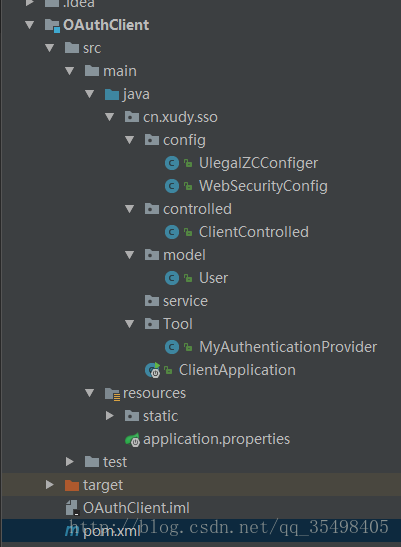我的OAuth2.0 客户端项目目录

pom 的配置
<?xml version="1.0" encoding="UTF-8"?> <project xmlns="http://maven.apache.org/POM/4.0.0" xmlns:xsi="http://www.w3.org/2001/XMLSchema-instance" xsi:schemaLocation="http://maven.apache.org/POM/4.0.0 http://maven.apache.org/xsd/maven-4.0.0.xsd"> <parent> <artifactId>OauthText</artifactId> <groupId>OauthText</groupId> <version>1.0-SNAPSHOT</version> </parent> <modelVersion>4.0.0</modelVersion> <artifactId>OAuthClient</artifactId> <dependencies> <dependency> <groupId>org.springframework.security.oauth</groupId> <artifactId>spring-security-oauth2</artifactId> </dependency> <dependency> <groupId>org.springframework.boot</groupId> <artifactId>spring-boot-starter-security</artifactId> </dependency> </dependencies> </project>
核心配置UlegalZCConfiger
@Bean public OAuth2RestOperations restTemplate() { AccessTokenRequest atr = new DefaultAccessTokenRequest(); OAuth2RestTemplate template = new OAuth2RestTemplate(resource(), new DefaultOAuth2ClientContext(atr)); ResourceOwnerPasswordAccessTokenProvider provider = new ResourceOwnerPasswordAccessTokenProvider(); template.setAccessTokenProvider(provider); return template; } private ResourceOwnerPasswordResourceDetails resource() { ResourceOwnerPasswordResourceDetails resource = new ResourceOwnerPasswordResourceDetails(); resource.setClientId("000000"); resource.setClientSecret("0000000"); resource.setAccessTokenUri("http://192.168.100.1000:56/oauth/token");// Oauth2.0 服务端链接 resource.setScope(Arrays.asList("read","write"));// 读写权限 resource.setUsername("0000000"); resource.setPassword("0000000"); resource.setGrantType("password");// Oauth2.0 使用的模式 为密码模式 return resource; }
上图username 和password 要与服务端自定义验证的账户和密码相同。setClientId和setClientSecret要与服务端数据库配置一样。如下字段

之后为前端拦截验证
package cn.xudy.sso.config; import cn.xudy.sso.Tool.MyAuthenticationProvider; import org.springframework.beans.factory.annotation.Autowired; import org.springframework.context.annotation.Bean; import org.springframework.context.annotation.Configuration; import org.springframework.security.authentication.AuthenticationManager; import org.springframework.security.config.annotation.authentication.builders.AuthenticationManagerBuilder; import org.springframework.security.config.annotation.method.configuration.EnableGlobalMethodSecurity; import org.springframework.security.config.annotation.web.builders.HttpSecurity; import org.springframework.security.config.annotation.web.configuration.WebSecurityConfigurerAdapter; /** * Created by Joe on 2017/8/8. */ @Configuration @EnableGlobalMethodSecurity(prePostEnabled = true)//开启security注解 public class WebSecurityConfig extends WebSecurityConfigurerAdapter { @Bean @Override protected AuthenticationManager authenticationManager() throws Exception { return super.authenticationManager(); } @Autowired private MyAuthenticationProvider provider;//自定义验证 @Override protected void configure(HttpSecurity http) throws Exception { // 全部通过 // http.csrf().disable().authorizeRequests() // .anyRequest() // .permitAll(); //允许所有用户访问"/"和"/home" 条件判断 http.csrf().disable() .authorizeRequests() .antMatchers("/login", "/page-login.html").permitAll() //其他地址的访问均需验证权限 .antMatchers("/*.html").authenticated() .and() .formLogin() //指定登录页是"/login" .loginPage("/login") .defaultSuccessUrl("/otherPage")//登录成功后默认跳转到"/index.html" .permitAll() .and() .logout() .logoutUrl("/logout") .logoutSuccessUrl("/login")//退出登录后的默认url是"/login" .invalidateHttpSession(true) .permitAll(); } @Autowired public void configureGlobal(AuthenticationManagerBuilder auth) throws Exception { //将验证过程交给自定义验证工具 auth.authenticationProvider(provider); } }
如果为条件验证,前端请求的话经过次方法,自定义验证代码WebSecurityConfig
/** * 自定义验证方式 */ @Override public Authentication authenticate(Authentication authentication) throws AuthenticationException { String username = authentication.getName(); String password = (String) authentication.getCredentials(); System.out.println("=-=-=-=-=:"+username); // 假装请求数据库 User user=new User(); Collection<? extends GrantedAuthority> authorities = AuthorityUtils.commaSeparatedStringToAuthorityList("USER"); return new UsernamePasswordAuthenticationToken(user, password, authorities); } @Override public boolean supports(Class<?> arg0) { return true; }
这是ClientControlled 请求
@RestController public class ClientControlled { @Autowired private OAuth2RestOperations oauthRestTemplate; @PostMapping(value = "/login") public String saveCuringEvidence(@RequestBody User user ){ System.out.println("---------------------Client"+user.getUsername()); // 重点请求服务端 oauthRestTemplate.postForEntity("http://192.168.1.100:9595/log",user,String.class); return user.getUsername(); } }
最后建议先看看我写的服务端 两方配套使用
http://www.cnblogs.com/memoryXudy/p/7805178.html